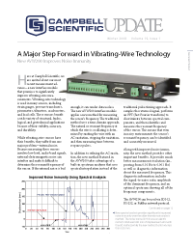Some companies are engineering firms that contract out their services. Others are marketing outlets that focus solely on sales and service. Still others are mainly contract manufacturers. Campbell Scientific on the other hand, is engineering, marketing, and manufacturing, all wrapped up in one. About half of us work in manufacturing, a fourth in marketing, a sixth in engineering, and the rest in supporting roles.
From our beginnings in 1974, engineering shaped the kind of company we have become. A problem existed among meteorologists on how to measure average wind over a half-mile distance, so Eric Campbell, the cofounder of Campbell Scientific and our first engineer and president, developed the CA9 anemometer. A short while later, about the time the CMOS (low-power) microprocessor was invented in the late ‘70s, the first smart, programmable, battery-powered measuring device that incorporated this new technology (later known as the CR21 datalogger) was developed by Eric with the help of two or three others.
Over the years, the Engineering Department has grown along with the rest of the company, consistently maintaining our roots in innovative measurement instrumentation. You can see the fruits of our labor in:
- The current line of CRBasic dataloggers
- A wide variety of weather stations
- A multitude of sensors, from the CS616 soil-water sensors to the 3-D CSAT3 sonic anemometer
- Sensor interfaces like the new, innovative AVW200 Vibrating Wire Interface
- The myriad of communication interfaces from the COM220 phone modem to the NL115 Internet module
- PC software products that enable our customers to see the results of their field experiments
Currently, Campbell Scientific’s Engineering Department has ten electrical and computer engineers, seven mechanical and manufacturing engineers, and ten software engineers, along with a small but invaluable support staff of documentation administrators, draftsmen, technicians, and interns. Unlike the current trend in other companies, virtually all of our engineering work is done in house by these personnel—including conceptualization, schematic capture, board layout, 3-D mechanical capture, early prototypes, board turns and packaging design, documentation and programming for the pick-and-place machines and the machining center, and shepherding everything through the initial manufacturing runs.
A case in point is the making of the CR1000 datalogger. Recognition of the benefits and need for a product like this had been ruminating for a year or two in the company. Parts obsolescence of the CR10X was a mounting concern for Manufacturing. Marketing saw potential for a datalogger that matched the CR10X’s ruggedness and popularity but with a few new features. The same engineers that designed the CR10X saw the benefits of using modern microprocessors and larger memory, and the potential for increased versatility and user accessibility through their new CRBasic language and PakBus network communications.
This motivated Campbell Scientific to open a project, and a team of half a dozen people got to work. Jody Swenson, our analog design specialist, improved upon Eric Campbell’s original, innovative design for the CR10 that Jody had carried forward to the CR10X. Then Dave Israelsen had the idea to incorporate this and a lot more into a Campbell Scientific application-specific integrated circuit (ASIC) to save cost and space—and our first experience in designing an ASIC began.
In the meantime, Dave Madsen and I began work on the operating system. We used much of what we had learned from the CR10X and the CR9000, while trying to keep up with the new ideas for instructions and functionality that came in. In parallel, Rex Bodrero and Evan Campbell were designing the packaging and working with the machine shop for early prototypes. Finally, all through the course of this hardware design, Jon Trauntvein and several other software engineers were creating what would become LoggerNet, the software that could communicate with the modern dataloggers and display the information measured and logged.
At Campbell Scientific, Engineering and Marketing have always been very close. As engineers, we spend much of our time studying the laws of physics and the workings of modern technology so that we can design measurement systems that benefit our customers. Much of our time is spent figuring out problems and working up designs with paper, pencil, computers, lab benches, soldering irons, calculators, data books, and our thinking caps. But a key to our success at designing the right products is our understanding of the problems that match our specific capabilities. So we are communicating with Manufacturing personnel that will build what we design, and especially with Marketing and our customers so that the product ends up being a real service to someone.
This process of defining the product of the future is not just a simple question of, “Tell me, you in Marketing, what to build.” In the beginning, no one told Eric, “I need a datalogger.” The word didn’t even exist back then. But when we as engineers dig deep into what our customers are up against, and when at the same time we really love applying the latest technology, then solution can meet problem, embodied in the products we develop. It’s win-win all the way around. That is what engineering is all about at Campbell Scientific.

